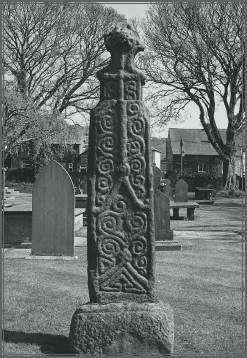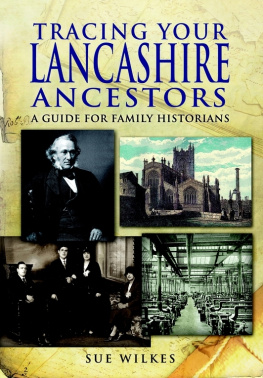LANCASHIRES
H ISTORIC
P UBS
P ETER T HOMAS

One of the tenth-century Celtic crosses at Whalley (see p. 92).

First published in 2006 by Sutton Publishing
Reprinted in 2010 by
The History Press
The Mill, Brimscombe Port
Stroud, Gloucestershire, GL5 2QG
www.thehistorypress.co.uk
Reprinted 2011
This ebook edition first published in 2013
All rights reserved
Peter Thomas, 2010, 2013
The right of Peter Thomas to be identified as the Author of this work has been asserted in accordance with the Copyright, Designs and Patents Act 1988.
This ebook is copyright material and must not be copied, reproduced, transferred, distributed, leased, licensed or publicly performed or used in any way except as specifically permitted in writing by the publishers, as allowed under the terms and conditions under which it was purchased or as strictly permitted by applicable copyright law. Any unauthorised distribution or use of this text may be a direct infringement of the authors and publishers rights, and those responsible may be liable in law accordingly.
EPUB ISBN 978 0 7509 5435 8
Original typesetting by The History Press

A short distance from the Redwell Inn at Arkholme is the delightful river walk along the Lune at Kirkby Lonsdale.

The packhorse bridge and church at Croston.
Authors Note
Readers will have noticed with sorrow the closure of many pubs, a few of which are featured in this book.
For regulars their local became a meeting place for the community and a news exchange to be enjoyed over their drinks and meals.
Landlords grew to know their customers through their days and times, as well as their orders. One I remember most warmly knew one of his regulars was losing his sight and was having a problem crossing the busy road to the pub. Who but the landlord used to bring him safely across the road?
The history of a pub, sometimes very ancient, shows in its architecture. Whatever the building is and does today, it is worth going to see.
See and enjoy: go in if its open!
I NTRODUCTION
T he pub is so much part of our tradition that, like the village green or the marketplace, it seems to have been with us throughout our history. Yet it was not always as it is now, neither was it originally called a public house; todays local, however small, is licensed and regulated, a far cry from the early drinking houses where home-brewed ale was sold.
Scraps of evidence tell us that barley was being grown in England long before the Romans came; their writers suggest that an intoxicating drink was already being produced here through the soaking of grain. How much earlier is difficult to say, but one can imagine that the knowledge of how to brew and the attractive product would have been eagerly passed on. This would, of course, have been a domestic brew consumed at home; perhaps if there was a surplus it was bartered or sold.
The Roman tabernae, or drinking places, in their settlements and along the many miles of Roman roads, mark the first use of the word tavern that we can recognise in our day. The Romans distinguished these premises with a bunch of vine leaves outside; wine was the most common drink, although ale was sold as well. Apart from this, we have the voice of the Christian Church condemning drunkenness to tell us that there was much excessive drinking. In the eighteenth century the Archbishop of York ruled that priests should not eat or drink in taverns.
The so-called Dark Ages and the reigns of Saxon kings saw the establishment of ale-houses and taverns that was to lead to todays public houses. The number grew rapidly, selling mostly home-brewed ale and mostly run by women, known as brewsters or ale-wives.
By the 1300s ale selling was still on a very small scale. We can safely conclude that the accommodation was only the ale-house kitchen and the only facility a warm fire. Because of the limitations, most sales must have been off the premises. Because there was so much poverty it was very likely that some ale-wives were driven to brewing and selling ale from necessity; they could possibly earn a little at harvest time, or when the price of barley made brewing worth while.
With an increase in the population and better wages, a rising demand gave ale-houses selling a good ale an opportunity to grow; food and social activities began to be offered, especially in towns. To mark these permanent ale-houses the use of ale-stakes a pole with a bush at the end became common and was soon made a requirement. In the 1400s the official licensing of ale-houses was introduced. By then the pattern of Englands drinking houses was becoming clear:
Inns These were the smallest in number, but largest in size, with the best standard of accommodation and widest range of food and drink. When coach travel brought passengers who needed overnight accommodation, it was the inns that provided it and offered stabling for horses. These coaching inns are easily recognised even today; an example is the Coach & Horses at Whitefield.
Inns became the focus for the social life of wealthy residents. They were the venues for balls and assemblies so beloved of Jane Austens characters, and places where the local hunt would meet. Their size (often the largest building in the area after the church) made them suitable for business and council meetings; their locations encouraged their use by carriers for collections and deliveries. Their courtyards, stables and outbuildings made excellent commercial sense. Because of their quality, style and size, many of them were able to continue, successfully retaining their traditional role as inns. Others, aspiring to higher things, adopted the title hotel. Either way, this was the quality end of the market.
Taverns Lower down the social order and providing drinking facilities for upper-middle-class customers, taverns sold wine and basic food, but rarely offered accommodation. Once the railways had arrived the place of taverns in the scheme of things would be clearer with neighbouring establishments known respectively as the Station Hotel and the Station Tavern.
Taverns had a good deal of competition from higher-quality ale-houses and from coffee-houses in their age of popularity; eventually numbers began to fall and they began to lose a separate identity. By 1800 few taverns could be distinguished from ale-houses.
By the eighteenth century there was little difference between smaller inns, taverns and ale-houses. At the same time a new name began to cover most of this group: the public house, possibly through some sort of recognition of its place as a public ale-house. This would have acknowledged its uniqueness as a private home, yet open to the public for the sale of ale. From the earlier, primitive one room and fire, many pubs, especially in towns, provided a parlour and a bar, vault or taproom. Social activities now increased, both in the pub and outside.
Ale-houses and early pubs had a very limited range of drinks, mainly ale, although cider and perry, for example, were available in districts in the west of England. The introduction of hopped beer from Flanders altered all that; the first recorded beer import was in 1400 in Sussex and its popularity quickly spread, particularly in the south. By 1600 beer had replaced ale in most pubs; the introduction of hops to the usual brewing ingredients of water, malt and yeast allowed a wide variety of flavours and strengths to be produced.
Next page






















